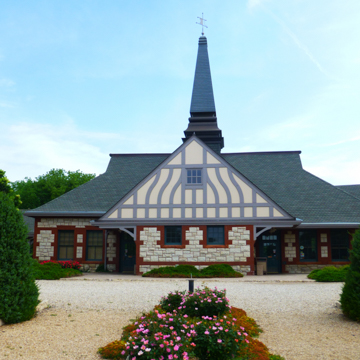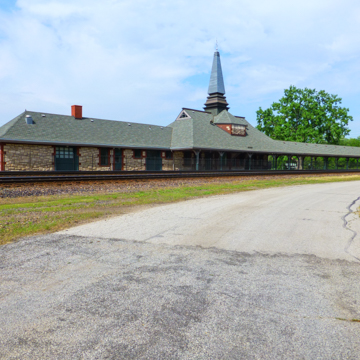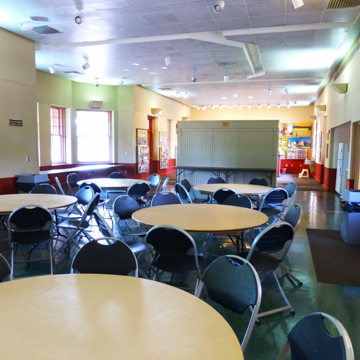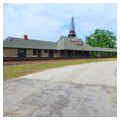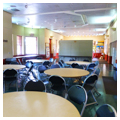You are here
Lawrence Visitor Center
The Union Pacific Depot has been an important landmark in Lawrence for over 125 years. The building can be loosely described as Richardsonian Romanesque, but draws from a range of precedents including H.H. Richardson’s residential work. The depot was designed by Van Brunt and Howe, one of the region’s most highly respected architectural firms in the late nineteenth century.
The Leavenworth, Pawnee and Western Railroad, which later became the Union Pacific Railroad, was incorporated in Kansas in 1854. The line from Leavenworth to Lawrence was completed in 1864, and a small wooden depot was built at the Lawrence stop. When Charles F. Adams, President of the Union Pacific Railroad, visited the original depot twenty years later and found it in a dilapidated condition, he contacted his friend Henry Van Brunt and commissioned him to design a more substantial building. The building Van Brunt and Howe designed would become a prototype for other small depots they completed for the Union Pacific Railroad.
The center of the building sits beneath a tall hipped-roof with a large, half-timbered gable protruding from the south or entry elevation. The hipped roof is topped with a 75-foot spire. Doors below the gabled form originally led to waiting rooms on either side of the trainmaster’s office. The building features an attached mass on the east, which housed the freight handling area, and a long, open canopy carried on cast-iron columns that stretches to the west to protect the loading platform. The walls are of rusticated limestone, quarried near Junction City, which is trimmed with red bricks and red stone that were quarried in Colorado.
The tracks run along the north side of the Kansas River, while the city of Lawrence occupies slightly higher ground on the south side of the river. The depot has undergone a number of changes since its construction. A flood in 1903 washed away the platform canopy. A fire in 1928 destroyed much of the main roof; it was rebuilt without the tall spire, and with asbestos shingles rather than the original slate shingles. The building was remodeled in 1944. The interior was reconfigured to create a single large waiting room, and many of the interior finishes were replaced with more modern materials. On the exterior, the sliding freight doors were replaced with overhead garage doors, and the brick on the loading platform was replaced with concrete.
Passenger service was discontinued in 1971, and after 1984, freight trains ceased service as well. The building sat vacant while local preservation groups lobbied to save the depot. In 1991 the depot was deeded to the city, and community groups began raising the money needed to rehabilitate the building. Five years later it opened as the Lawrence Visitor Center. The exterior was reworked to restore the building to its original appearance. The interior was reconfigured to accommodate a large meeting room, a small theater, and a welcome center. It is now operated by the city’s parks and recreation department, which has established an elegant formal garden at the front the building. The rejuvenation of Lawrence’s Union Depot is a testament to the dedication and generosity of the community, the spirit of collaboration between public and private entities, as well as to the inspiration provided by the building’s remarkable and resilient design.
References
“Lawrence Union Pacific Passenger Depot,” Douglas County, Kansas. Register of Historic Kansas Places Nomination Form, 1992. Kansas State Historical Society, Topeka, KS.
Writing Credits
If SAH Archipedia has been useful to you, please consider supporting it.
SAH Archipedia tells the story of the United States through its buildings, landscapes, and cities. This freely available resource empowers the public with authoritative knowledge that deepens their understanding and appreciation of the built environment. But the Society of Architectural Historians, which created SAH Archipedia with University of Virginia Press, needs your support to maintain the high-caliber research, writing, photography, cartography, editing, design, and programming that make SAH Archipedia a trusted online resource available to all who value the history of place, heritage tourism, and learning.














